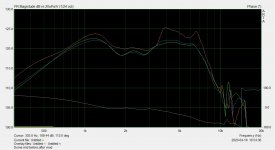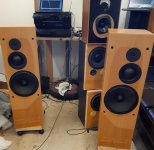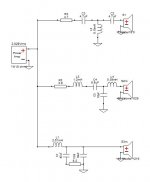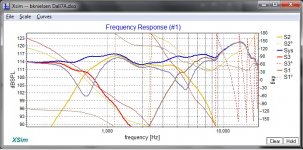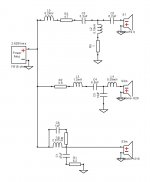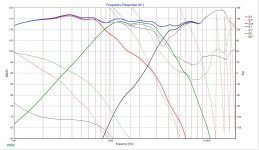I got a pair of these old speakers in the weekend at a fair price, and nearby my home. Thinking of fixing them without paying too much.
Cabinets are in good condition, but the veneer has a 'tan', and a few stains (coffee or drinks, not sure). Suggestions on cosmetic fixes?
Ok, so first thing I noticed was a blown tweeter on one. Luckily these D19 tweeters are common, and I had an extra pair in the garage. However not exactly the same. The originals had stacked magnets, so I only used the face plate/dome from my spare tweeters. I also added a felt pad to the pole piece, and some ferro fluid to the gap. The originals had no ferro fluid, but the spares did have it. I figured some FF would prevent them from blowing again.
The working original had a top octave bump with a sharp null in the response at maybe 15k, this disappeared after the 'fix', but the top octave bump is a bit higher. I'm guessing some reflection from the pole piece gave the null, and it's gone now with the felt. No graphs from the tweeter mod.
The woofers have bad surrounds, so I did a quick glue fix to be able to measure them and listen to the speakers. I have ordered new surrounds, since the listening impression was positive. A little bright sounding for my taste maybe.
So, next thing was to measure the drivers and 'reverse engineer' the XO.
I measured the coils with the XO disconnected, but did not desolder the coils. I think this should be ok for accuracy, but with a question mark for the woofer coil. I did the measurement at 100Hz though, so the parallel RC should not influence much. All caps are el-lyte except for the tweeter. The woofer coil is ferrite core, the rest are air cored.
Measuring the drivers got me really annoyed with the dome mids.. horrible! First thought was to replace them with some cone drivers or some Dynaudio D52's but then again, the whole thing about these speakers are these dome mids... So, I took them apart to see if something could be done. The pole plate is a flat piece of metal, and the center vent is also a piece of metal with some holes, so first thing I did was to put some felt pads on the pole plate, and some Monacor MDM (wool mix) in the vent hole. Sadly this did nearly nothing. Only some minor wrinkles were improved in the high frequencies that are really 'out of band' anyway. So, I figured, I have nothing to loose, do or die 🙂 I added some sticky surround glue to the suspension/VC-joint (front), and some ModPodge in a 1cm wide ring on the back of the dome, starting from voice-coil joint, and 1cm in on the dome. This improved things, but I wanted more. There was still some ringing in the upper band. I made a 'triangle' of sticky surround glue on the back on the dome, with the three tips of the triangle touching the inner limit of the ModPodge. This damped a lot of the ringing in the upper band. Waterfall started to look decent, and FR was improved too.
There is still an annoying bump just over 1k, but it seems the baffle is part of it too, it looks better off center. I have before and after FR of this.
I have taken measurements to be able to simulate it in X-sim, and generally they seem to line up pretty well in phase, but the woofer to mid is a bit troublesome, with a bump in the FR in the XO-area. It seems the design sacrifices FR for phase alignment, and I guess I would do the same. I have played around with it a little bit, but have not found a magic solution. Ok, time aligning the woofer would be nice.. But it seems the mid and woofer don't match too well, and it's not the woofers fault IMHO..
So, if you're bored, stuck at home in quarantine, here is a chance to pass some time 😉 I have seen there has been a few of these group exercises lately, so I thought I would post this one with a slightly different starting point. No driver selection, no baffle size mods etc. I would like to time align the drivers, but it would hurt the looks pretty bad..
Suggestions are welcome. I don't want to spend a fortune on components, but I do have some boxes with XO parts, and LCR-meter to unwind some coils etc.
In general, I think the speakers have potential to sound pretty good. Distortion from the drivers seems low, waterfalls are fairly clean, and the cabinets are pretty nice and rigid.
An odd thing is they used foam right behind the woofers, I might experiment with that, but the bass sounds pretty good 'as is'. The woofers are marked 16ohm, and the rest 8ohm, so they should be an easy load for weak amps.
My thoughts on XO:
-Good phase alignment
-Don't like high Q circuits
-Fairly smooth FR, I prefer slightly sloping down from maybe 1kHz and up.
-No need for crazy power, and they don't have to be 'high efficiency' sacrificing FR either.
About measurements:
-SPL not calibrated.
-Driver offset measurements were taken in two positions: one between tweeter and mid, and one between mid and woofer, at abt 1meter distance. I was trying to emulate a far field listening position in this way. All measurements are in the zipfile. The offsets in the dxo-file are my guesstimates based on this.
Cabinets are in good condition, but the veneer has a 'tan', and a few stains (coffee or drinks, not sure). Suggestions on cosmetic fixes?
Ok, so first thing I noticed was a blown tweeter on one. Luckily these D19 tweeters are common, and I had an extra pair in the garage. However not exactly the same. The originals had stacked magnets, so I only used the face plate/dome from my spare tweeters. I also added a felt pad to the pole piece, and some ferro fluid to the gap. The originals had no ferro fluid, but the spares did have it. I figured some FF would prevent them from blowing again.
The working original had a top octave bump with a sharp null in the response at maybe 15k, this disappeared after the 'fix', but the top octave bump is a bit higher. I'm guessing some reflection from the pole piece gave the null, and it's gone now with the felt. No graphs from the tweeter mod.
The woofers have bad surrounds, so I did a quick glue fix to be able to measure them and listen to the speakers. I have ordered new surrounds, since the listening impression was positive. A little bright sounding for my taste maybe.
So, next thing was to measure the drivers and 'reverse engineer' the XO.
I measured the coils with the XO disconnected, but did not desolder the coils. I think this should be ok for accuracy, but with a question mark for the woofer coil. I did the measurement at 100Hz though, so the parallel RC should not influence much. All caps are el-lyte except for the tweeter. The woofer coil is ferrite core, the rest are air cored.
Measuring the drivers got me really annoyed with the dome mids.. horrible! First thought was to replace them with some cone drivers or some Dynaudio D52's but then again, the whole thing about these speakers are these dome mids... So, I took them apart to see if something could be done. The pole plate is a flat piece of metal, and the center vent is also a piece of metal with some holes, so first thing I did was to put some felt pads on the pole plate, and some Monacor MDM (wool mix) in the vent hole. Sadly this did nearly nothing. Only some minor wrinkles were improved in the high frequencies that are really 'out of band' anyway. So, I figured, I have nothing to loose, do or die 🙂 I added some sticky surround glue to the suspension/VC-joint (front), and some ModPodge in a 1cm wide ring on the back of the dome, starting from voice-coil joint, and 1cm in on the dome. This improved things, but I wanted more. There was still some ringing in the upper band. I made a 'triangle' of sticky surround glue on the back on the dome, with the three tips of the triangle touching the inner limit of the ModPodge. This damped a lot of the ringing in the upper band. Waterfall started to look decent, and FR was improved too.
There is still an annoying bump just over 1k, but it seems the baffle is part of it too, it looks better off center. I have before and after FR of this.
I have taken measurements to be able to simulate it in X-sim, and generally they seem to line up pretty well in phase, but the woofer to mid is a bit troublesome, with a bump in the FR in the XO-area. It seems the design sacrifices FR for phase alignment, and I guess I would do the same. I have played around with it a little bit, but have not found a magic solution. Ok, time aligning the woofer would be nice.. But it seems the mid and woofer don't match too well, and it's not the woofers fault IMHO..
So, if you're bored, stuck at home in quarantine, here is a chance to pass some time 😉 I have seen there has been a few of these group exercises lately, so I thought I would post this one with a slightly different starting point. No driver selection, no baffle size mods etc. I would like to time align the drivers, but it would hurt the looks pretty bad..
Suggestions are welcome. I don't want to spend a fortune on components, but I do have some boxes with XO parts, and LCR-meter to unwind some coils etc.
In general, I think the speakers have potential to sound pretty good. Distortion from the drivers seems low, waterfalls are fairly clean, and the cabinets are pretty nice and rigid.
An odd thing is they used foam right behind the woofers, I might experiment with that, but the bass sounds pretty good 'as is'. The woofers are marked 16ohm, and the rest 8ohm, so they should be an easy load for weak amps.
My thoughts on XO:
-Good phase alignment
-Don't like high Q circuits
-Fairly smooth FR, I prefer slightly sloping down from maybe 1kHz and up.
-No need for crazy power, and they don't have to be 'high efficiency' sacrificing FR either.
About measurements:
-SPL not calibrated.
-Driver offset measurements were taken in two positions: one between tweeter and mid, and one between mid and woofer, at abt 1meter distance. I was trying to emulate a far field listening position in this way. All measurements are in the zipfile. The offsets in the dxo-file are my guesstimates based on this.
Attachments
Last edited:
I think the subject of the thread got to be a bit misleading, maybe should have been 'improvement' or 'XO-modification', not really a 'restoration'. Seems it can't be changed after the fact.
Try some ferrofluid in the mids, if they do not already have some.
This will lower the impedance peak and sharpen the highpass' slope a little.
If you don't like it, this you can undo.
This will lower the impedance peak and sharpen the highpass' slope a little.
If you don't like it, this you can undo.
Dali7 XO modifications
I saw that the impedance curve of the simulation did not match the one I measured, so I did a re-check.
Measured the frequency response of the standard setup, swapped polarity on the drivers to see the dips etc. I checked the XO again, and found I did a (double) mistake in the first one I posted. Since I cant change the first post, I upload the corrected files here.
What I realized is that the woofer to mid phase tracking is way off. Almost no difference when I swapped polarity, and the new simulation agrees with that. FR is flatter than the first faulty version though
I hooked some small coils in series with the tweeter do tame the top peak, and that also improved phase tracking between mid and tweeter. I have to tune that a little in the sim.
Woofer to mid is the main challenge here.
I saw that the impedance curve of the simulation did not match the one I measured, so I did a re-check.
Measured the frequency response of the standard setup, swapped polarity on the drivers to see the dips etc. I checked the XO again, and found I did a (double) mistake in the first one I posted. Since I cant change the first post, I upload the corrected files here.
What I realized is that the woofer to mid phase tracking is way off. Almost no difference when I swapped polarity, and the new simulation agrees with that. FR is flatter than the first faulty version though
I hooked some small coils in series with the tweeter do tame the top peak, and that also improved phase tracking between mid and tweeter. I have to tune that a little in the sim.
Woofer to mid is the main challenge here.
Attachments
Last edited:
Try some ferrofluid in the mids, if they do not already have some.
This will lower the impedance peak and sharpen the highpass' slope a little.
If you don't like it, this you can undo.
Sorry, I don't have that much FF. Those gaps would swallow a lot, they are wide and large diameter! Would be nice to try though..
Not sure what would happen to the coil former though, seemed to be some kind of paper surface on the former, so it might not like oil.
I had the Jubilee model made in 500 numbered sets. As far as I know the crossover is the same, just with better components than standard (I think I might have it on a note somewhere).
Regarding tonal balance mine had to much midrange - fatiguing. Not very good phase coherence between drivers driven from crossover either.
The crossover with measurements is here if you wan't to give it a try: Dali7A Nyt Delefilter - SpeakerBuilder Forum - Page 1 (in Danish, which should be OK for "our neighbors" 🙂)
I also removed some of the foam from the bass chamber. You really can't judge the bass before changing foam surrounds.
Beware, the Jubilee model used an OEM version of this tweeter: H0532-08 19TAFD/G
Based on last I heard them at my friends place (they were driven by a Denon amp), I would probably put ½-1 Ohm extra in series with the tweeter towards the amp.
Have fun with the restoration 🙂
Regarding tonal balance mine had to much midrange - fatiguing. Not very good phase coherence between drivers driven from crossover either.
The crossover with measurements is here if you wan't to give it a try: Dali7A Nyt Delefilter - SpeakerBuilder Forum - Page 1 (in Danish, which should be OK for "our neighbors" 🙂)
I also removed some of the foam from the bass chamber. You really can't judge the bass before changing foam surrounds.
Beware, the Jubilee model used an OEM version of this tweeter: H0532-08 19TAFD/G
Based on last I heard them at my friends place (they were driven by a Denon amp), I would probably put ½-1 Ohm extra in series with the tweeter towards the amp.
Have fun with the restoration 🙂
Dali speakers are in the class of speaker I would not upgrade without a full speaker analysis, kind of like the Infinity of yore.
While I can respect the designer choices in lifting the tweeter levels (see any modern review) the rest of it sounds messy/nasty.
Going back to a blank sheet of paper may be the best option.
While I can respect the designer choices in lifting the tweeter levels (see any modern review) the rest of it sounds messy/nasty.
Going back to a blank sheet of paper may be the best option.
Thank you for the link!
I will try to simulate that XO. A total redesign that will require a lot of components though..
I will try to simulate that XO. A total redesign that will require a lot of components though..
Dali speakers are in the class of speaker I would not upgrade without a full speaker analysis, kind of like the Infinity of yore.
While I can respect the designer choices in lifting the tweeter levels (see any modern review) the rest of it sounds messy/nasty.
Going back to a blank sheet of paper may be the best option.
Yes, I'm not going to throw a lot of money on upgrades, but hoping to do some tweaks with stuff I have in boxes, and hopefully improve the sound 🙂
I will probably end up selling them cheap or giving them away when they are taking up space anyway..
The 1 major benefit to a pair of speakers like this is they can be an amazing learning platform, assuming you keep your mods cheap.
Do a complete electro-acoustical analysis, simulate, rethink, implement. 🙂
It worked for me.
Do a complete electro-acoustical analysis, simulate, rethink, implement. 🙂
It worked for me.
The 1 major benefit to a pair of speakers like this is they can be an amazing learning platform, assuming you keep your mods cheap.
Do a complete electro-acoustical analysis, simulate, rethink, implement. 🙂
It worked for me.
What do you mean by a complete electro-acoustical analysis?
In this case I suspect some work was done by the engineers already. XO points are probably in the right region for the drivers etc.
I'm thinking about it as a learning platform too. If I was to do something 'serious' I guess I would throw out the mid first, and probably the other drivers too, come to think of it.. but in this case I'm just aiming at improving things a little.
This is what I got with the XO in the link. Seems measurements and/or driver performance is far from equal.
As I understand it he did all measurements at tweeter height and 1m distance, I think that offsets things a bit.
To my understanding, my way taking two positions between the drivers, is at least a little bit better 😉
Low end is better aligned in phase, but it's costing a lot of copper and caps, and a lower XO that the mid might not like. Everything comes at a cost.
Thoughts on that?
As I understand it he did all measurements at tweeter height and 1m distance, I think that offsets things a bit.
To my understanding, my way taking two positions between the drivers, is at least a little bit better 😉
Low end is better aligned in phase, but it's costing a lot of copper and caps, and a lower XO that the mid might not like. Everything comes at a cost.
Thoughts on that?
Attachments
Rally,
It means to measure the acoustical and electrical properties of the drivers in place. You don't need Thiel/Small parameters, but the frequency response, distance and impedance of the drivers. Especially distance. 🙂
Once you have those three, your Xsim should be able to simulate the entire speaker (FR + Impedance) as well as be a guide to rethink the whole crossover. 🙂
It means to measure the acoustical and electrical properties of the drivers in place. You don't need Thiel/Small parameters, but the frequency response, distance and impedance of the drivers. Especially distance. 🙂
Once you have those three, your Xsim should be able to simulate the entire speaker (FR + Impedance) as well as be a guide to rethink the whole crossover. 🙂
I just completed a similar exercise with an existing 3-way speaker. I used VituixCAD, which enabled me to simultaneously model off-axis response. I took measurements from -90deg through +90deg at 10deg intervals. A turntable I had made for this purpose made it easy. Once you get the measurements done, it is easy to try out various XO variants.
I checked the simulation. Time offsets I determined by measuring driver parallel in phase/out of phase and fitting simulation are:
bass: 306.6 us
mid: 21.8 us
tweeter: 0 us
Maybe that can be of help. You need impedance files as well to get good results. I should probably be able to find them if needed.
bass: 306.6 us
mid: 21.8 us
tweeter: 0 us
Maybe that can be of help. You need impedance files as well to get good results. I should probably be able to find them if needed.
Yep. You need driver (in place) FR, impedance and relative offset (distance) to create a working simulation. 🙂
Best,
E
Best,
E
Yep. You need driver (in place) FR, impedance and relative offset (distance) to create a working simulation. 🙂
Best,
E
It's all there and done.
Everything included in the zip-file. Measured impedance, all drivers FR, and FR for mid and tweeter together, same for woofer and mid. Offsets are in the dxo, as derived from those measurements.
That is what I meant by measuring the offsets with two mic-positions. I did tweeter/mid with the mic between the two, and woofer/mid with the mic just under the mid, to emulate far listening distance. Not that it made such a big difference.
Simulation of the standard XO adds up with real measurements, that's what I meant by inverting polarities and thing adding up after the correction to the simulated XO.
VC:
I tried VC once some time ago, but I did not like the XO-part of it. It felt a bit 'clumsy' compared to Xsim.
Last edited:
I checked the simulation. Time offsets I determined by measuring driver parallel in phase/out of phase and fitting simulation are:
bass: 306.6 us
mid: 21.8 us
tweeter: 0 us
Maybe that can be of help. You need impedance files as well to get good results. I should probably be able to find them if needed.
Thank you for chiming in! 🙂
The offsets I get (in inches, as in x-sim) are Tweeter 0, Mid -0,29, Woofer +2,16.
So, mid is a little bit closer than the tweeter (makes sense), and woofer is far behind. This is with the previously mentioned mic-positions.
As you see the FR, especially the mid & tweeter is not even close to your measurements, so there is something funny about that. I did some experiments with sheep wool in the mid cabinet, but did not really see any difference, so it must be something else.
Last edited:
Here is a first 'draft' for a cheap and simple modification that improves things a little bit. Woofer to mid phase is not great, but improved from std.
The trade off, is that the woofer plays a little bit more treble, but it's so far down, so hopefully it should not be a problem.
Tweeter response and mid to tweeter phase tracking also improved. Looking at the woofer to tweeter phase, it's also not too far off.
Impedance is same or higher than standard XO.
I think I should see if I can improve the 'low end' response of the mid (box etc), I think that could make things easier.
The trade off, is that the woofer plays a little bit more treble, but it's so far down, so hopefully it should not be a problem.
Tweeter response and mid to tweeter phase tracking also improved. Looking at the woofer to tweeter phase, it's also not too far off.
Impedance is same or higher than standard XO.
I think I should see if I can improve the 'low end' response of the mid (box etc), I think that could make things easier.
Attachments
- Home
- Loudspeakers
- Multi-Way
- Dali 7 restoration.
